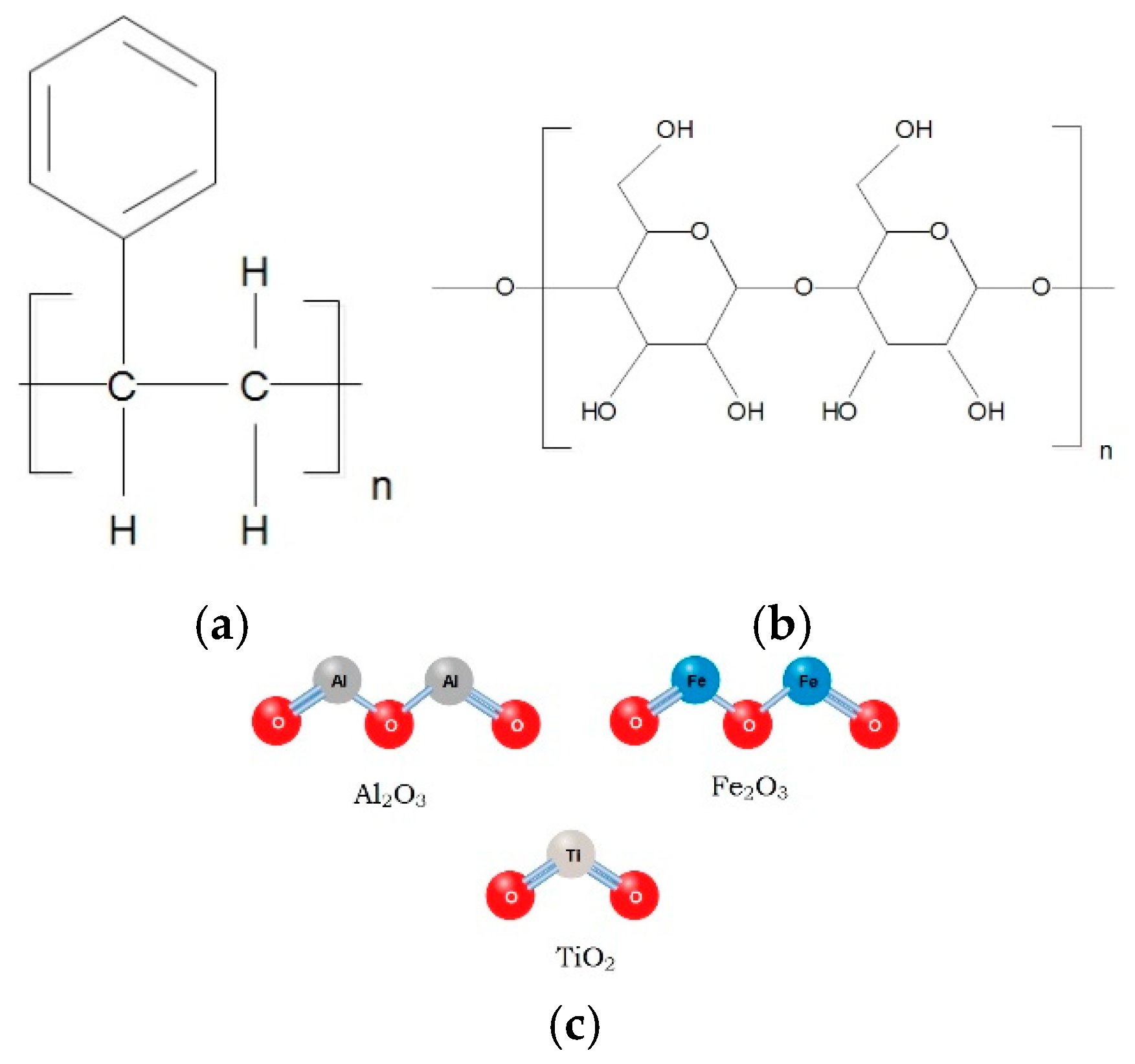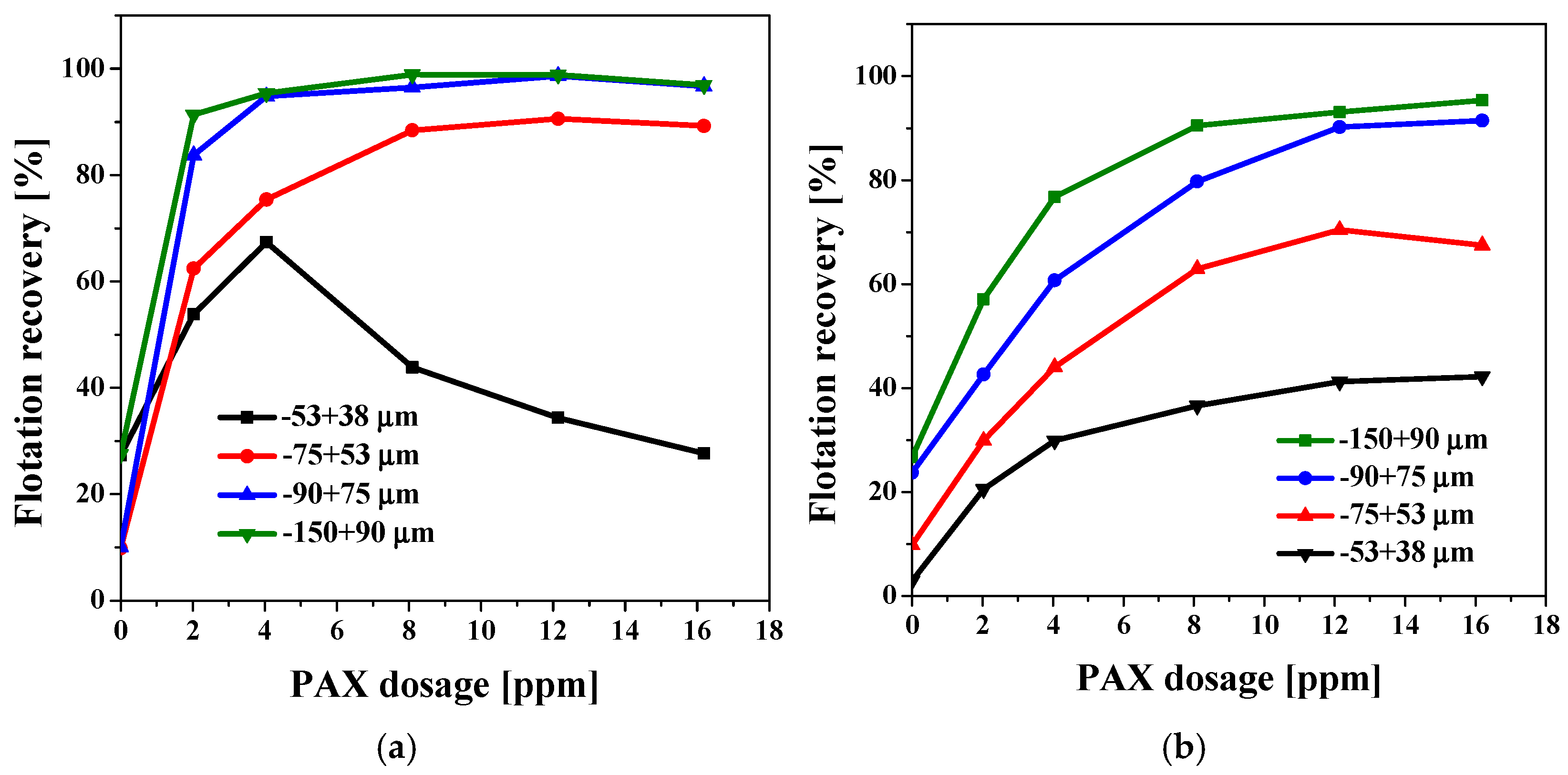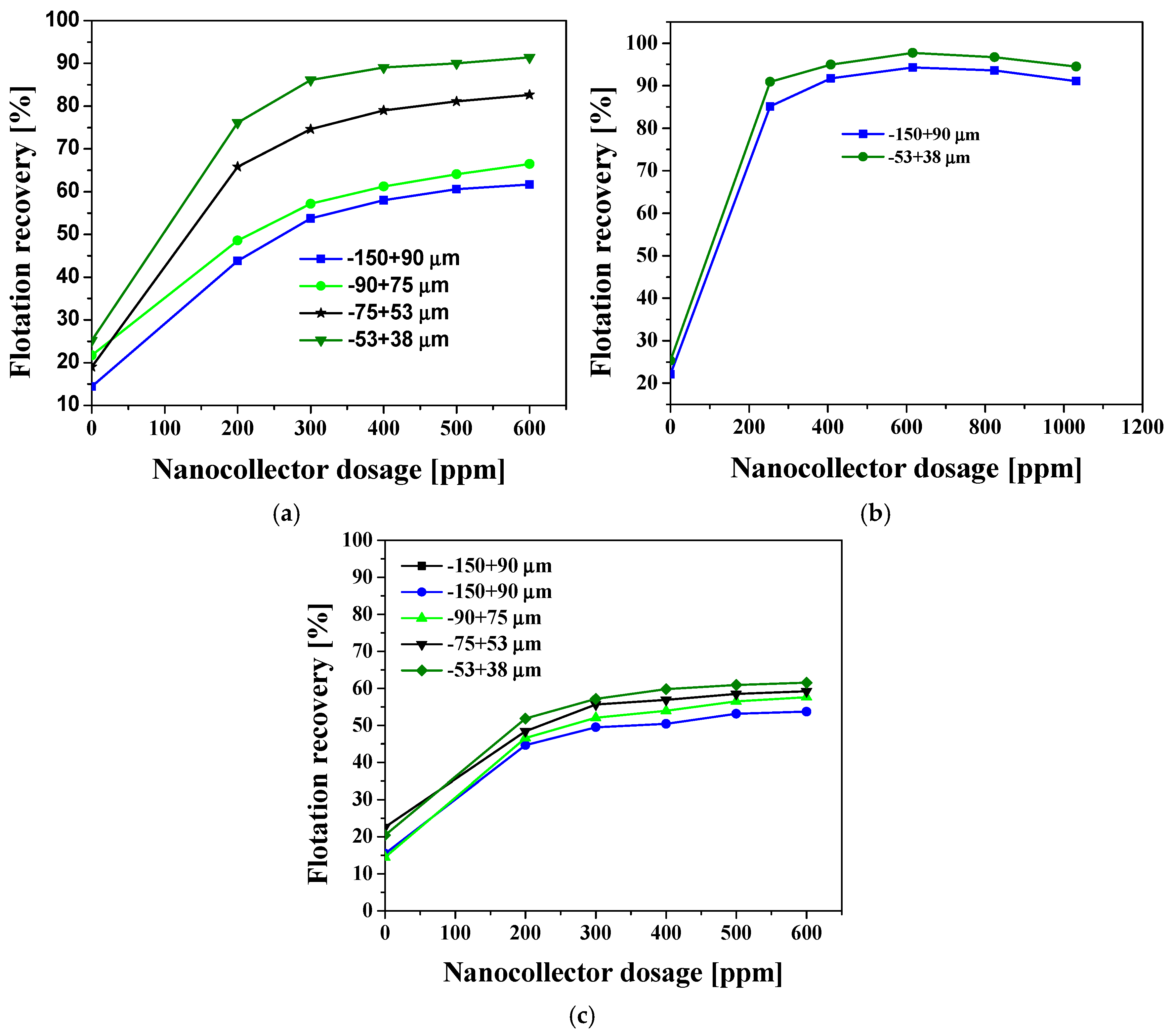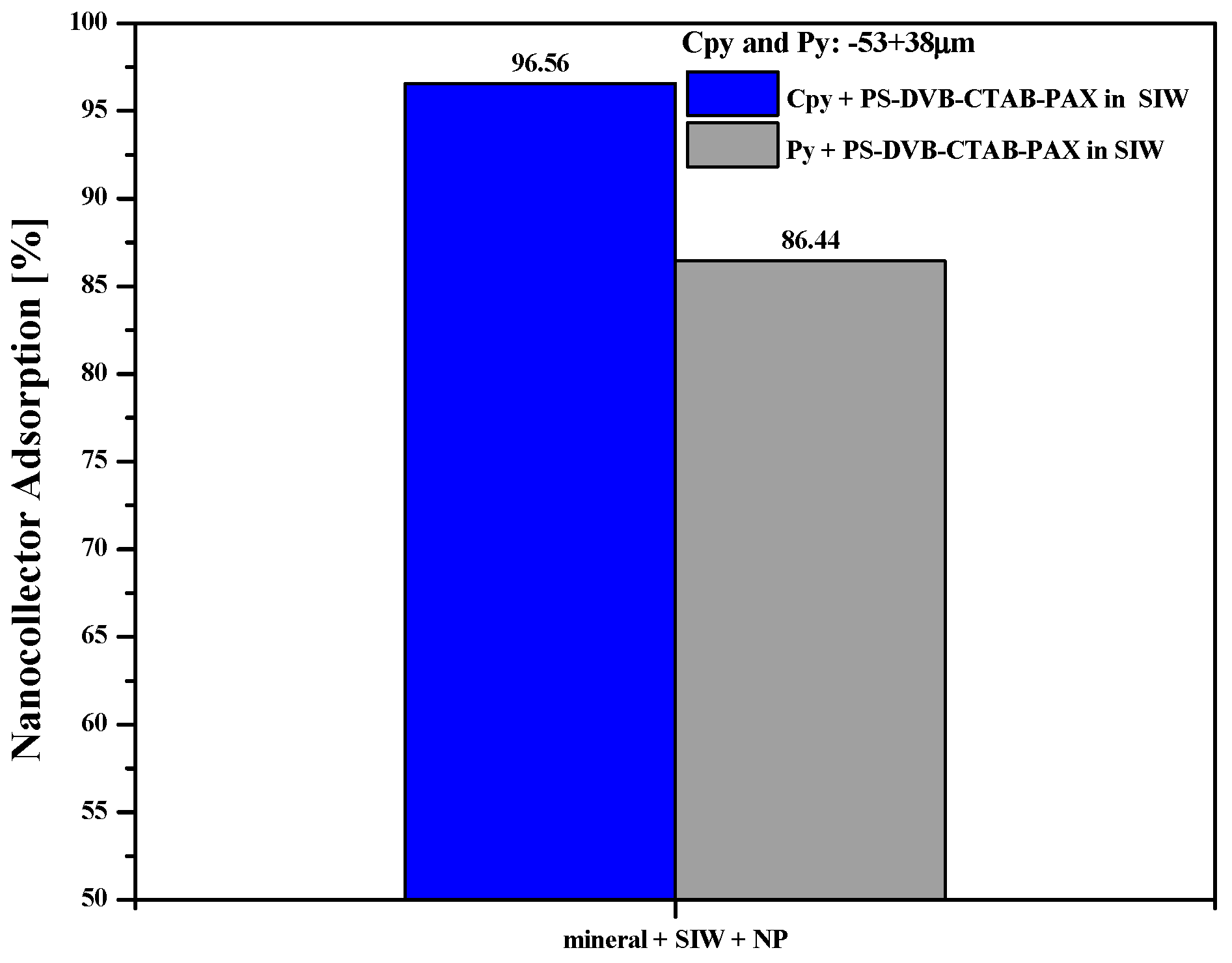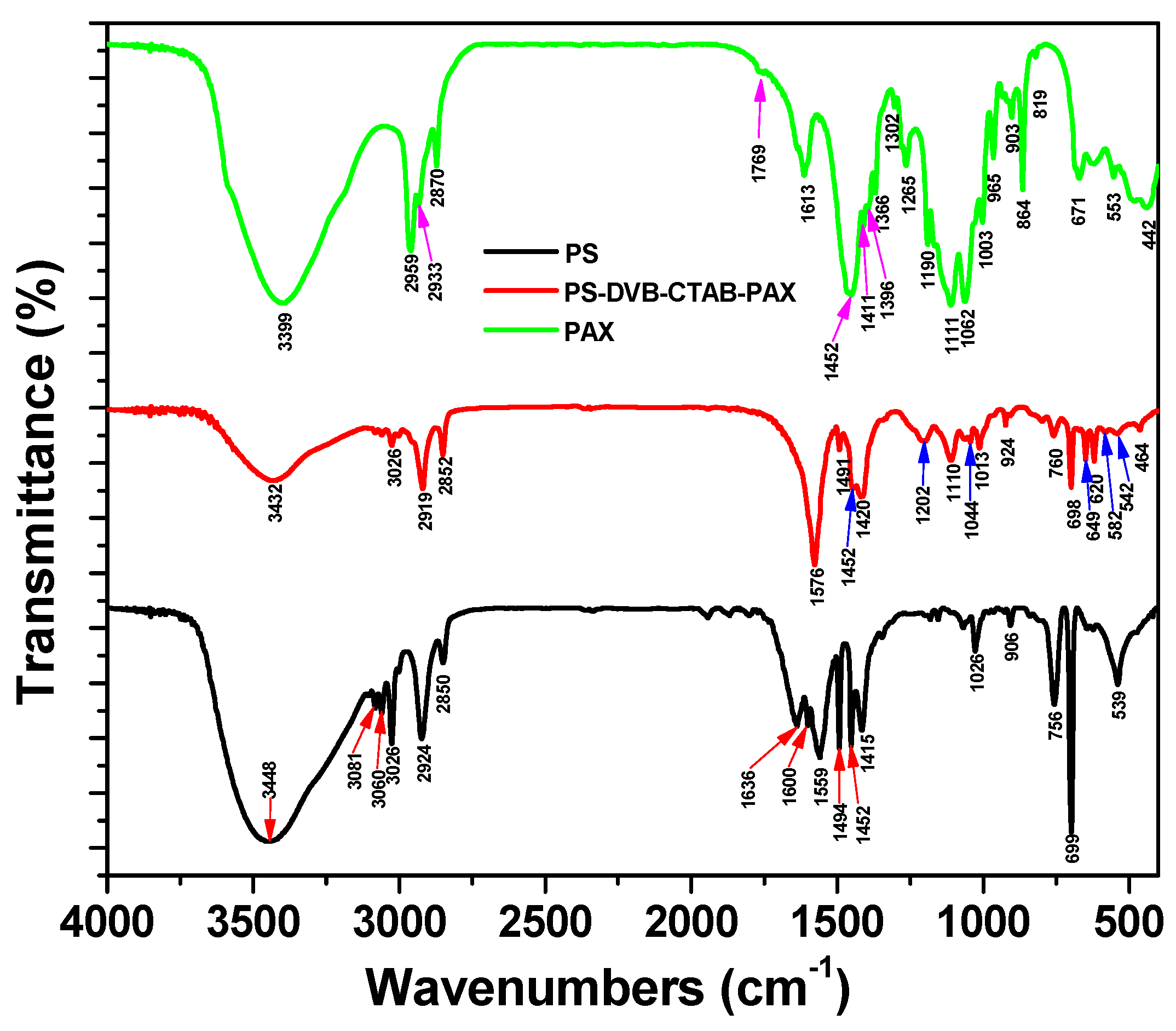1. Introduction
The flotation of fine particles (<~20 μm) remains a significant challenge in mineral processing. As copper deposits present more complex and lower-grade mineralogy, the generation of fine particles increases after the comminution stages. Unfortunately, traditional thiol-type collectors (e.g., xanthates) show limited performance for this type of particle, where performance is hindered by low bubble–particle collision and adhesion efficiencies. To overcome these limitations, high collector doses are often required, which makes the operation more complex, increases costs, and reduces the quality of the concentrates, since excessive collector doses can induce increased gangue floatability. Numerous studies have shown that, in current flotation processes, a significant amount of fine copper sulfide particles is discharged into the tailings, as reported by [
1]. These tailings, subsequently deposited in storage facilities (TSFs), contain a significant amount of copper that is not recovered. This phenomenon is particularly relevant in the current context of the depletion of conventional copper ores, which has led to considering tailings as a potential source of this metal. Suppes and Heuss-aßbichler [
2] estimated that TSFs contain approximately 0.13 gigatons of copper, representing 15% of current geological reserves, a figure also supported by [
3,
4].
In the last decade, the application of nanotechnology in flotation has emerged as a promising alternative. The search in Scopus using the keyword “nanoparticles flotation collectors” shows a steady increase in research on organic and inorganic nanoparticles as flotation collectors since the 2000s (
Figure 1a), with a more pronounced growth in the last decade, particularly for polymer-based collectors (
Figure 1b,c). According to Legawiec and Polowczyk [
5], these reagents are classified based on the properties of their core, which can be chemically modified through the incorporation of specific functional groups. Among the most studied nanocollectors are those based on polystyrene, cellulose, and inorganic materials (
Figure 2), with the first two standing out for their effectiveness in modifying surface hydrophobicity. Although the functionalization of inorganic nanoparticles is a well-known procedure [
6], their application in flotation is recent and still limited due to their low affinity for mineral surfaces, which reduces hydrophobicity and process efficiency [
5,
7].
In 2011, Yang et al. [
8] first reported a technology using hydrophobic polymeric nanocollectors designed to adsorb onto the surface of hydrophilic particles, rendering them hydrophobic and facilitating their attachment to air bubbles. In this pioneering study, ~46 nm cationic charged polystyrene nanoparticles (stabilized with CTAB) were able to coat 43 μm glass spheres (simulating mineral particles) and promote their almost complete flotation. Interestingly, a coverage of only ~5% of the glass surface with nanoparticles was sufficient to achieve high efficiencies, in contrast to conventional molecular collectors, which typically require coverage of at least 25% of the surface to achieve acceptable recoveries [
8]. The adsorption of these hydrophobic nanocollectors dramatically increased the particle–bubble adhesion force: the force required to detach a coated particle increased from ~0.0086 μN (for a clean particle) to ~1.9 μN with the nanoparticle coating. These results demonstrate the enormous potential of hydrophobic nanoparticles as collectors, by inducing localized superhydrophobicity at the mineral surface and ensuring stable contact with bubbles, even for microscopic particles [
9].
Since then, multiple investigations have delved into the development of functionalized polymeric nanocollectors for metal sulfide flotation. Yang et al. [
10] expanded the concept by evaluating polystyrene nanoparticles in various contexts. They demonstrated that the effectiveness of nanocollectors correlates with their surface hydrophobicity, identifying that a minimum water–nanofilm contact angle of ~50–85° is required to achieve high recoveries. Following Yang et al., the contact angle is determined on nanoparticle-coated surfaces or films formed by the nanoparticles, which allows evaluating the collectively induced hydrophobicity rather than that of isolated particles. They also found that nanoparticles with softer polymer shells (styrene copolymers with n-butyl acrylate, which have a lower glass transition temperature) adhere more firmly to mineral surfaces, acting as more efficient collectors than rigid nanoparticles [
11]. This is attributed to the fact that “soft” nanocollectors can deform slightly upon adsorption, creating larger contact areas and stronger van der Waals forces with the substrate. Similarly, decreasing the size of nanoparticles below ~50 nm tends to improve their collector performance, possibly by increasing the coverage density and penetration at the air-water interface. In parallel, Dong et al. [
12] investigated the effect of morphology (including anisotropic Janus-type particles) and surface adhesion, concluding that smaller, non-spherical, soft-shelled nanocollector particles achieve higher binding forces and better flotation performance [
12].
More recently, research has emerged on polymeric nanocollectors functionalized with specific active groups, seeking to improve selectivity and performance in more complex systems. For example, Yang et al. [
13] explored polystyrene nanocollectors modified with vinyl imidazole groups, demonstrating that they can chelate Ni
2+ ions on the surface of pentlandite and promote its selective flotation [
14]. Indeed, these imidazolium-functional nanocollectors achieved specific adsorption on pentlandite, even in the presence of other, more negatively charged particles (e.g., glasses or silicates), thereby displacing slime coatings and detaching impurities from the surface of the valuable mineral. He et al. [
15] synthesized polystyrene nanoparticles bearing thiazole groups by emulsion polymerization and reported that these sulfur- and nitrogen-functional nanocollectors significantly increased the recovery of ultrafine chalcopyrite. For their part, Abarca et al. [
16] proposed a ‘nanoparticle library’ approach to choose optimal collectors, and established three key physicochemical characteristics that an effective nanocollector must meet: (1) high surface hydrophobicity, sufficient to adhere to air bubbles; (2) colloidal stability in solution, avoiding aggregation between nanoparticles; (3) adsorption selectivity, so that nanoparticles are preferentially deposited on the valuable mineral (chalcopyrite) and not on the gangue (pyrite or others).
Murga et al. [
17] developed imidazole-functionalized polystyrene nanoparticles (called St-CTAB-VI) as collectors for chalcopyrite. Their flotation tests showed that incorporating the imidazolium group into the nanocollector substantially improves Cu recovery compared to similar unfunctionalized nanoparticles, which was attributed to specific interactions with Cu–Fe sites on the chalcopyrite surface. An et al. [
18] extended the use of hydrophobic nanocollectors to the coal sector, demonstrating that the deposition of polystyrene nanoparticles on the carbonaceous surface increased its hydrophobicity and surface roughness, improving bubble capture. Even natural nanomaterials have been explored: Choi et al. [
19] used hydrophobic talc (a layered silicate) nanoparticles as a collector for fine malakite (Cu
2CO
3(OH)
2), significantly increasing its floatability without using traditional collectors. On the other hand, Hrůzová et al. [
20] introduced micro- and nanoparticles of organosolv lignin—a wood-derived biopolymer—as a sustainable and biodegradable collector for Cu-Ni-Zn sulfides. Interestingly, these lignin nanocollectors achieved recoveries of more than 80% of chalcopyrite from a Cu-Ni ore. When applied to a complex Cu-Pb-Zn ore, they enabled a 50% reduction in xanthate dosage, yielding final recoveries of up to 91% Cu, 85% Pb, and 98% Zn, surpassing the results achieved with xanthate alone.
Despite the advances described, these reagents have not yet been applied on an industrial scale. First, most studies to date have been conducted in simplified laboratory systems (microflotation tests in deionized water with pure minerals). The performance of nanocollectors needs to be evaluated in more complex environments, for example, using industrial water with high ionic strength (simulating seawater or recycled process water) and the presence of dissolved impurities. Colloidal stability and collector effectiveness can be drastically altered under these conditions due to the compression of the electrical double layer and the possible aggregation of nanoparticles. Second, there is a notable lack of research focused on mixed mineralogical systems. In real-world contexts, chalcopyrite must be selectively floated from pyrite and other gangues; however, most work on nanocollectors has been limited to single-mineral systems. The simultaneous interaction of nanocollectors with multiple sulfides (e.g., a chalcopyrite–pyrite mixture) has not been sufficiently studied. Aspects such as the preferential adsorption of the nanocollector on chalcopyrite versus pyrite, the possible hydrophobic co-aggregation between valuable particles induced by the nanoparticles, or the competition for adsorption sites in the presence of clay coatings remain open questions. Similarly, the compatibility of nanocollectors with traditional reagents (frothers, pH modifiers, depressants) in a complete flotation system remains to be explored. That is, how do nanocollectors behave in a conventional cell with intense agitation, bubbles generated by aeration, and in combination with commercial frothers?
Considering the above, this work hypothesizes that it is possible to improve the recovery of fine chalcopyrite particles under industrial water conditions (water with a certain salinity level) by using functionalized polymeric nanocollectors that maximize adsorption on chalcopyrite and confer robust hydrophobicity resistant to detachment. To verify this hypothesis, the objectives of the study include: (1) synthesize polymeric nanoparticles functionalized with specific groups with affinity towards chalcopyrite, (2) characterize their adsorption on chalcopyrite and pyrite surfaces (evaluating parameters such as zeta potential, contact angle), (3) compare the flotation performance of these nanoparticles versus traditional collectors in microflotation tests, and (4) analyze the physicochemical mechanisms involved in the nanocollector–mineral interaction (role of surface charge, hydrophobic interactions and colloidal structure at the solid/liquid interface).
3. Results and Discussions
3.1. Mineralogical Characterization of Chalcopyrite and Pyrite
X-ray diffraction (XRD) confirmed the presence of the main sulfide phases and quantified the pre-sorting efficiency. The mineral purity values reported in
Table 5 and
Table 6 were determined by quantitative phase analysis of the XRD patterns obtained before and after magnetic and manual pre-cleaning, using a Bruker D8 Advance diffractometer (Bruker AXS GmbH, Karlsruhe, Germany). Before treatment, chalcopyrite showed mass fractions of 53.3% (−53 + 38 µm) and 49.6% (−150 + 90 µm), accompanied by pyrite (22.7%), magnetite (8.8%), and isocubanite (9.5%) (
Table 5,
Figure 4a). After magnetic cleaning and manual inspection, the mineral purity increased to 91.3% for chalcopyrite and 94.0% for pyrite (
Table 6,
Figure 4b), with the virtual disappearance of the secondary phases in the powder patterns (
Figure 5).
3.2. Zeta Potential Measurements
Figure 4 compares the evolution of the zeta potential (ζ) of chalcopyrite (Cpy) and pyrite (Py) between pH 4–10 in distilled water (DW) and in the SIW. As shown in
Figure 6, in DW, both sulfides maintain a net negative charge throughout the studied range, with magnitudes of approximately −35 mV for pyrite and ≈ approximately −30 mV for chalcopyrite at pH 4. In contrast, the presence of electrolytes in SIW compresses the electrical double layer, shifting the potential towards less negative values (−10 to −15 mV), which brings the point of apparent zero charge (PZC) closer to pH ≈ 3.5–4 for Cpy and ≈4.5 for Py.
Two synergistic phenomena explain this shift: (i) Ionic screening and compression of the double layer. Na
+ and, especially, Ca
2+ cations reduce the thickness of the diffuse layer (κ
−1), decreasing the magnitude of ζ as the threshold of 0.01 M in ionic strength is exceeded [
28]; (ii) Specific adsorption of Ca
2+. Calcium exhibits a greater affinity for sulfur-containing and oxo-hydroxylated sites, neutralizing charges, and increasing the potential density in the Stern layer [
29].
The lower absolute value of ζ under saline conditions has two direct implications for flotation with nanocollectors: (i) Reduction in particle–bubble electrostatic repulsion, favoring bubble adhesion and, therefore, metallurgical recovery; (ii) Facilitating the adsorption of collectors and nanocollectors, since the lower charge density favors short-distance hydrophilic interactions [
30].
The zeta potential measurements were conducted to validate the electrokinetic behavior of chalcopyrite and pyrite under the specific conditions of this study (synthetic industrial water versus distilled water) and to provide a direct link with the flotation results. Although the general trend of reduced ζ-potential in saline media has been previously reported, our results confirm this effect for the studied system and demonstrate its relevance to nanocollector adsorption. The lower absolute ζ-potential values facilitate the attachment of collectors and nanocollectors, explaining the improved chalcopyrite recovery discussed in
Section 3.3.
In SIW, Na+ and Ca2+ ions compress the electrical double layer, reducing the absolute ζ-potential values. This favors collector and nanocollector adsorption by decreasing particle–bubble electrostatic repulsion. The effect was experimentally validated through triplicate zeta potential measurements across a wide pH range and further supported by TOC adsorption and contact angle results, which confirmed preferential affinity toward chalcopyrite.
3.3. Flotation Experiments
In SIW at natural pH, chalcopyrite flotation exhibits two distinct zones (
Figure 7a). In the first, between 0 and 4 ppm PAX, all fractions improve sharply: the −150 + 90 µm and −90 + 75 µm particles reach ≈97%–99% at only 2–4 ppm, while the −75 + 53 µm fraction reaches 90% at 8 ppm. This rapid increase reflects the fact that xanthate adsorption kinetics is very efficient for particles ≥ 53 µm: a single monolayer is sufficient to ensure stable bubble–particle collision and adhesion.
The second zone appears when the dosage exceeds the optimum (~4 ppm). The medium and coarse fractions maintain a plateau (≤3 points of variation), but the finest fraction, ≈53 + 38 µm, experiences a drastic drop: it goes from a peak of ≈67% to <35% at 16 ppm. The cause is not a lack of hydrophobicity, but rather a kinetic "bottleneck" governed by the drainage of the liquid film. Having a larger specific surface area and lower inertia, these particles generate a longer, slower-draining film. Excess PAX forms surface multilayers, which raises the osmotic pressure within the film, thereby increasing its interfacial viscosity (Marangoni effect). Water takes too long to escape, the film does not break, and the particle rebounds or is swept away by the upward flow. Hence, a marginal overdosage results in fines alone, leading to losses of up to 40 points of recovery. In pyrite, the metallurgical response varies almost linearly with PAX dosage up to ~8 ppm, and only from 12 to 16 ppm do the coarse fractions (−150 + 90 and −90 + 75 µm) reach a plateau of 92%–95% recovery. This gradual behavior occurs because the surface is partially passivated by ferric oxides and sulfates, allowing the collector to be consumed first in displacing this layer and forming Fe-xanthate complexes that are less hydrophobic than the Cu-xanthate complexes of chalcopyrite. Consequently, the supersaturation that causes multilayering and re-dispersion in chalcopyrite fines is never generated. Furthermore, a large portion of the PAX remains chemically anchored, so that the concentration of free xanthate and K+ counterions in the liquid–gas film remains relatively low, and the interfacial viscosity barely increases. Film drainage does not slow down—not even for the finest fraction (−53 + 38 µm), which maintains a stable, albeit limited, recovery of around 40%. Thus, in pyrite, excess collector does not trigger the post-optimum drop: the mineral acts as a PAX sink until it becomes saturated, and fines recovery is controlled by the collision probability, not by drainage problems, making it clear that optimization should focus on increasing collector coverage (≥12 ppm) or on using nanocollectors capable of activating fines without drastically increasing reagent consumption.
It is important to highlight that the microflotation tests were conducted under nitrogen aeration in the Hallimond cell; however, the pulp conditioning was previously carried out in an open beaker for 15 min. During this period, pyrite can undergo spontaneous surface oxidation upon contact with dissolved oxygen, forming a thin film of Fe3+ oxyhydroxides and ferric sulfates. This film remains stable and retains its integrity even after the pulp is transferred to the Hallimond cell under a nitrogen atmosphere. This explains the different behavior observed between chalcopyrite and pyrite. In pyrite, the oxidized layer acts as a partial barrier, modulating collector adsorption and preventing the over-saturation effect that causes the collapse in fine chalcopyrite. In contrast, chalcopyrite, being more prone to direct interaction with PAX and less likely to form stable films within the same exposure time, exhibits the rebound effect caused by the surface tension gradient. Consequently, the oxidized film on pyrite originates during the air-conditioning stage, which is consistent with the experimental observations.
Figure 8a demonstrates that the PS-DVB-CTAB-PAX nanocollector, without free PAX, completely disrupts the size hierarchy observed with conventional xanthate on chalcopyrite: the fines (−53 + 38 µm) are the first to exceed 90% and reach a plateau close to 98% at just 300 ppm, while the −150 + 90 µm fraction requires twice the dose to match this recovery. This confirms that the nanoparticles act as mobile “hook-up” sites; their positive charge, imparted by CTAB, neutralizes the slightly negative surface of chalcopyrite in SIW and generates hydrophobic microclusters that increase the impact cross section of low-inertia particles, raising the collision frequency and eliminating the kinetic limitation to film drainage that affected pure PAX. When the same nanocollector is fed along with traces of free PAX (
Figure 8b), the recovery increases even more rapidly: at ~100 ppm, chalcopyrite of all sizes already approaches 95%. Molecular xanthate first colonizes the high-energy Cu–S sites, lowering the local surface tension and facilitating the formation of a continuous hybrid monolayer by the partially PAX-coated nanoparticles. This synergy prevents supersaturation, allows the total collector dose to be reduced by one-third, and homogenizes the response between coarse and fine fractions.
In
Figure 8, it can be observed that, in the absence of reagent, the recovery of the fine fraction (−53 + 38 µm) is higher than that of the coarse fraction (−150 + 90 µm). This behavior is attributed to the fact that fine chalcopyrite particles possess a larger specific surface area, which increases the number of reactive sites and facilitates interaction with bubbles, even without the presence of a collector. Additionally, their partially oxidized or heterogeneous surfaces can generate hydrophobic patches that promote natural floatability, while their low inertia enhances attachment to bubbles under these conditions. In contrast, coarser particles rely more on collector-induced hydrophobicity to achieve efficient flotation, as their natural recovery is limited by surface heterogeneity and a lower probability of effective bubble contact. These factors explain the higher natural recovery observed for the fine fraction compared with the coarse fraction under identical conditions without a reagent.
In contrast, the curves in
Figure 8c reveal that, on pyrite, the same nanocollector only allows recovery to be scaled up to 60%–70%, with the reverse order: the fine particles obtain a small additional benefit, but the overall gain is modest. The reason is twofold: the pyrite surface, being more oxidized and acid-base-free and less prone to electrostatic interactions with CTAB, adsorbs fewer nanoparticles, leaving hydrophilic Fe(OH)
3 patches exposed; furthermore, the ability of PS-DVB-CTAB-PAX to release PAX by competitive exchange is limited, so that Fe-xanthate complexes are rarely generated. In the absence of supersaturation, the response is primarily controlled by the slow chemisorption of the polymer-anchored collector and by particle–bubble collisions, which explains the premature plateau. Overall,
Figure 8 demonstrates that the nanocollector confers inherent Cu/Fe selectivity, as it maximizes chalcopyrite flotation, especially of difficult-to-flotation fines, drastically reduces xanthate consumption when used in a mixture, and simultaneously limits pyrite recovery, resulting in a net improvement in industrial Cu–Fe separation under high-salinity conditions.
The effectiveness of the separation was defined by Cu/Fe selectivity rather than absolute recovery values. Although pyrite exhibited moderate recoveries, the Total Organic Carbon (TOC) results show that the nanocollector displayed preferential adsorption of 96.6% on chalcopyrite compared to 86.4% on pyrite, which limited the floatability of the latter to below 70%. This differential behavior explains the improved separation of chalcopyrite and pyrite.
The reported recoveries correspond to metallurgical values calculated from the masses of concentrate and tailings. For chalcopyrite and pyrite, the feed grade was determined by the high mineral purity (>91% and >94%, respectively, confirmed by XRD). This ensures that the reported values accurately reflect metallurgical performance.
3.4. Adsorption Experiments
Figure 9 shows the adsorption of the PS-DVB-CTAB-PAX nanocollector on the two minerals tested. Adsorption was 96.6% on chalcopyrite and 86.4% on pyrite, a difference of 10.2 % in favor of the valuable mineral, justifying the preferential nature of the collector on the chalcopyrite surface.
From a physicochemical perspective, the greater adsorption on chalcopyrite was attributed to stronger electrostatic interactions between the slightly negative surface of the copper sulfide and the cationic CTAB groups anchored to the copolymer. Once deposited, the nanoparticles developed localized superhydrophobicity that favored the formation of stable microagglomerates. On pyrite, the higher proportion of oxidized ferric species generated a less attractive surface field and led to lower preferential adsorption, despite sharing the same ionic strength and pH. This behavior reflects that surface chemistry—and not just net charge—governs the nanocollector’s affinity.
Differential adsorption supports the Cu/Fe selectivity observed in the flotation tests. By forming a denser hydrophobic layer on the chalcopyrite, PS-DVB-CTAB-PAX increased the probability of bubble-particle collision and adhesion, thereby boosting fines recovery without the need for overdosing thiol collectors. At the same time, the lower coverage on pyrite limited its floatability, improving overall separation and reducing concentrate dilution.
3.5. Contact Angle Measurements
Figure 10 presents the contact angles measured on chalcopyrite and pyrite under three experimental conditions. For chalcopyrite, the baseline value in deionized water was 56.4°, indicating a moderately hydrophobic surface. After the addition of potassium amyl xanthate (PAX), the contact angle increased to 60.2°, confirming the collector’s ability to induce surface hydrophobicity. Treatment with the PS-DVB-CTAB-PAX nanocollector further increased the angle to 86.5°, demonstrating a significant enhancement in hydrophobicity and placing the system within the range of highly non-wetting surfaces.
In the case of pyrite, lower contact angles were obtained under the same conditions, with 51.1° in deionized water, 58.3° after PAX treatment, and 75.1° after exposure to the nanocollector. These values reflect its more hydrophilic nature and the presence of an oxidized surface layer that limits adsorption compared to chalcopyrite. The high contact angles achieved with the nanocollector are attributed to the preferential adsorption of cationic nanoparticles on high-energy Cu–S sites of chalcopyrite, which is favored by electrostatic interactions with the CTAB groups. Once adsorbed, the polymer particles generate localized superhydrophobic domains, reducing solid–liquid interfacial free energy and increasing nanoscale roughness. Consequently, these effects enhance bubble–particle collision and adhesion efficiency, especially for fine particles, reducing the need for excessive thiol collector dosages and reinforcing the Cu/Fe selectivity demonstrated in previous sections.
The contact angle measurements provide preliminary evidence of the enhanced hydrophobic behavior induced by the PS-DVB-CTAB-PAX nanocollector compared to conventional reagents. The progressive increase in the contact angle from 56.4° in distilled water to 60.2° with PAX, and finally to 86.5° with the nanocollector, clearly indicates that surface modification by the polymeric nanoparticles significantly improves chalcopyrite hydrophobicity. In contrast, pyrite displayed smaller variations (from 51.1° to 75.1°), consistent with its partially oxidized surface and lower adsorption capacity. These differences in contact angle values suggest that the nanocollector not only enhances surface hydrophobicity but also contributes to the selective separation of chalcopyrite over pyrite, supporting the trends later confirmed by TOC and flotation results.
3.6. Morphological Analysis of Nanoparticles by SEM-EDX and TEM
Two of the main parameters evaluated in the characterization of nanoparticles (NPs) are size and shape.
Figure 11 presents the characterization of PS-DVB-CTAB-PAX nanoparticles obtained through electron microscopy. The SEM images (
Figure 11a) show a spherical morphology with a smooth and uniform surface, while the TEM images (
Figure 11b) reveal a tendency toward agglomeration into clusters, yet maintaining a well-defined spherical shape and homogeneous particle size.
3.7. Particle Size Distribution of the Nanocollectors
Figure 12 shows the particle size distribution of the PS-DVB-CTAB-PAX nanocollectors. Graph (a) corresponds to the frequency histogram, while graph (b) presents the probability plot (Q-Q plot) comparing the empirical distribution with a theoretical normal distribution.
The histogram (a), based on the analysis of 30 PS-DVB-CTAB-PAX nanoparticles, reveals a moderately narrow distribution with particle sizes ranging from 33.37 nm to 43.48 nm. Most particles cluster around the mean value of 38.8 nm with a standard deviation of 2.4 nm, indicating low dispersion and suggesting a consistent synthesis process. Moreover, the Q-Q plot (b) confirms a good fit to normality (p-value = 0.853).
3.8. Fourier Transform Infrared Spectroscopy (FTIR) Analysis
Figure 13 compares the spectra of polystyrene (PS), the PS-DVB-CTAB-PAX copolymer, and the PAX reagent. The PS spectrum exhibits characteristic signals in the regions of 3000–3100 cm
−1, attributed to C–H stretching vibrations of the aromatic ring, and 1500–1600 cm
−1, corresponding to C=C stretching vibrations of the same ring. When compared with the PS-DVB-CTAB-PAX copolymer spectrum, notable differences are observed, particularly in the 1100–1300 cm
−1 region, where new bands appear, indicating the incorporation of functional groups derived from copolymerization.
The PAX reagent spectrum is characterized by signals in the 3000–2800 cm
−1 range, associated with –C–H groups (CH
3 at 2959 cm
−1, CH
2 at 2933 cm
−1, and CH
3 at 2870 cm
−1) [
31,
32]. Additionally, a band at 1769 cm
−1 corresponds to the C=O bond of a ketone or aldehyde, characteristic of PAX due to the use of n-amyl alcohol in its synthesis. The signals between 1452 and 1003 cm
−1, together with the intense band at 1062 cm
−1, are assigned to C=S bond vibrations (carbon disulfide) [
33,
34].
It is noteworthy that the signals at 1452 cm
−1 and 1411 cm
−1 observed in the PAX spectrum coincide with those at 1452 cm
−1 and 1420 cm
−1 in the PS-DVB-CTAB-PAX copolymer, confirming the presence of the C=S group in the copolymeric structure [
33,
34]. Likewise, the band at 2933 cm
−1, associated with the –C–H (CH
2) group, suggests the effective integration of PAX into the copolymer [
31,
32].
FTIR spectra confirmed the incorporation of PAX functional groups into the PS-DVB-CTAB-PAX structure, as evidenced by the characteristic C=S (1062 cm−1) and CH2 (2933 cm−1) bands. These results, combined with SEM and TEM analyses, demonstrate the hybrid chemical–electrostatic adsorption mechanism of the nanocollector on chalcopyrite.
4. Conclusions
The results show that the PS-DVB-CTAB-PAX nanocollector represents a significant advance in reagent engineering for copper sulfide flotation. At the metallurgical level, the reagent increased the overall recovery of chalcopyrite to 98% in the −53 + 38 µm fraction, significantly outperforming potassium amyl xanthate (PAX), whose maximum recovery of fine particles failed to reach 70%.
The results show that the PS-DVB-CTAB-PAX nanocollector offers significant advantages over the conventional PAX collector due to its high specific surface area, which provides multiple simultaneous binding sites (multivalent effect), its ability to be functionalized with chemical groups that allow tuning selectivity toward specific minerals, and its flexible polymeric structure capable of generating superhydrophobic microdomains that enhance bubble–particle adhesion. In this context, the present study serves as proof of concept, demonstrating the feasibility of the PS-DVB-CTAB-PAX nanocollector under simulated industrial water conditions. This establishes the foundation for future research focused on multicomponent systems and validates its performance at the pilot scale.
The combination of the PS-DVB-CTAB-PAX nanocollector with PAX yielded an apparent synergistic effect, increasing recovery to values of >98%, while simultaneously maintaining recoveries above 95% for coarse particles, without the typical decrease associated with thiol collector supersaturation. The synergism is explained by (i) the preferential adsorption of the nanocollector on free surface sites, which seals hydrophilic voids left by PAX, and (ii) the localized superhydrophobicity induced by the nanoparticles, which reduces the interfacial free energy and inhibits re-detachment during drainage of the liquid film.
The total organic carbon, contact angle, and metallurgical recovery results consistently validate the adsorption mechanism of the PS-DVB-CTAB-PAX nanocollector on chalcopyrite and pyrite. Total organic carbon analysis confirmed preferential adsorption of 96.6% on chalcopyrite versus 86.4% on pyrite, correlating with the higher local density of Cu–S sites and the electrostatic affinity of the CTAB groups that promote the formation of a continuous nanometric monolayer. This coating generated localized superhydrophobicity, as evidenced by an increase in contact angle from 56.4° (for water) to 86.5° with the nanocollector. In contrast, pyrite exhibited lower hydrophobicity (75.1°) and reduced adsorption, consistent with its oxidized surface and limited buoyancy (<70%). These physicochemical differences directly translated into flotation behavior, where chalcopyrite achieved recoveries close to 98%, confirming strong Cu/Fe selectivity. From a phenomenological perspective, the nanoparticles acted as adhesion nuclei, enhancing the effective bubble–particle interaction area and mitigating kinetic limitations in fine particles, thereby explaining the superior recovery and selectivity observed experimentally.
The results confirm a direct relationship between the surface adsorption of the nanocollector and the metallurgical recovery of chalcopyrite. The Total Organic Carbon analysis revealed a progressive increase in adsorption with dosage, reaching 96.6% on chalcopyrite, which was reflected in the flotation tests through a proportional rise in recovery. Consistently, the contact angle values increased from 56.4° (in water) to 86.5° with the nanocollector, indicating greater hydrophobicity associated with broader surface coverage. Overall, these findings experimentally support the proposed mechanism, where a higher nanocollector dosage leads to greater adsorption and, consequently, higher recovery of the valuable mineral.
From a practical standpoint, the results obtained with the PS-DVB-CTAB-PAX nanocollector suggest a high potential for application in industrial flotation circuits, particularly in scenarios where maximizing fine particle recovery and reducing the consumption of traditional collectors are required. The observed synergy with PAX and the selectivity toward pyrite indicate that this type of nanocollector could help improve metallurgical efficiency and process sustainability by reducing dependence on conventional reagents. These findings support the feasibility of advancing toward pilot-scale testing in larger systems to evaluate their performance under more complex and representative operational conditions of the mining industry.

